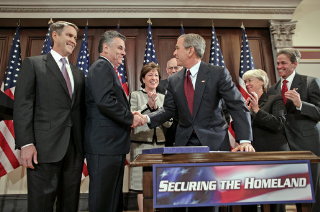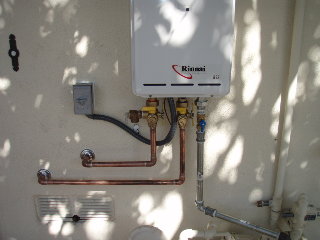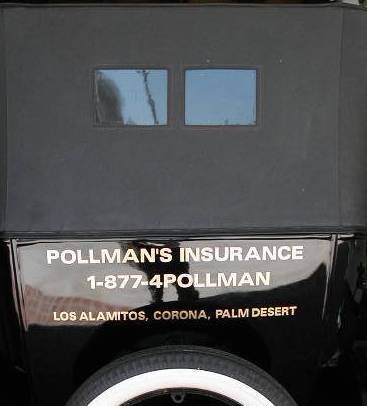|
In Depth/Perspective Here's Salient Text Of Congress-Passed, President-Signed, Industry-Backed Container Security Text In "SAFE Port" Act
Introduction / Perspective
| (October 13, 2006) -- On Sept. 30, Congress resolved differences between House and Senate versions of the "SAFE Port" Act (HR 4954) and passed the bill, sending it to President Bush who signed it today.
| 
President Bush shakes hands with House Homeland Security Committee chair Peter King (R., NY) after signing the bill. Also pictured from left are Sen. Bill First (R, TN), Sen. Susan Collins (R, ME), Sen. Robert Bennett (R, UT), Sen. Patty Murray (D, WA) and Sen. Norm Coleman (R, MN). White House photo |
LBReport.com posts extended portions of the bill's container-related provisions below.
Unless modified by Congress in future sessions, the verbiage will govern the level of protection offered to Long Beach residents for years to come.
For over six months as the legislation progressed through Congress, LB City Hall stayed publicly silent on the bill. Neither city management nor Councilmembers agendized the legislation for a public City Council discussion as it advanced. In contrast, across the bay, the Port of LB skillfully used public resources to influence the bill's substance.
In March 2006 (as previously reported by LBReport.com, the Port of LB hosted closed door meetings on the bill with key members of Congress [(Rep. Dan Lungren (R, Sacramento) Jane Harman (D., Southbay) and Loretta Sanchez (D., Garden Grove)]. As we reported at the time, elected LB Councilmembers weren't invited (A port staffer told us this was an oversight.)
Staff of Congressman Lungren's Homeland Security committee office separately confirmed to us that it had informed the office of Assemblywoman Betty Karnette (D., LB) that she wasn't welcome to attend the meeting with the Congressmembers.
As the bill progressed, the "American Ass'n of Port Authorities" -- in which the Port of LB is a major member -- urged Congress to defeat an amendment to the House version of the SAFE Port Act by Cong. Ed Markey, (D. MA) to require inspection of all incoming cargo containers. In May 2006, the amendment failed on a 202-222 vote (near party-line with Dems supporting, Repubs opposed).
In September 2006, Sen. Charles Schumer (D., NY) offered an amendment to require implementation by a date certain of a radiation scanning system already being used in Hong Kong. Industry interests opposed the amendment and the "American Ass'n of Port Authorities" urged passage of the bill without it. The Senate tabled (killed) Sen. Schumer's amendment on a 61-37 vote with Senators Dianne Feinstein (D., CA), Barbara Boxer (D., CA) and Hillary Clinton (D. CA) voting against killing the amendment.
In signing the bill into law at the White House today (Oct. 13), President Bush said, "The most solemn responsibility of the federal government is to protect the American people. And since September the 11th, the administration and the Congress have worked together and we've led an unprecedented effort to safeguard our homeland. In other words, we learned the lessons of that attack." President Bush continued:
President Bush: ...Our seaports are a gateway to commerce, a source of opportunity, and a provider of jobs. Our ports could also be a target of a terrorist attack, and we're determined to protect them.
Since September the 11th, we've launched a series of new efforts to improve port security. We worked with Congress to pass the Maritime Transportation Security Act, which required American ports and vessels to adopt strict new security measures. We made wider use of intelligence to screen cargo and target suspicious containers for inspection. We worked with foreign partners to improve their security procedures. And with the bill I sign today, we renew a clear commitment: We will work tirelessly to keep our nation safe and our ports open for business.
The SAFE Port Act will build on progress and help us protect our ports in three key ways. First, the SAFE Port Act will strengthen physical security measures at our ports by helping us harness the power of technology. The bill authorizes the development of 21st century inspection equipment, so that Customs agents can check inside cargo containers for dangerous materials without having to open them. The bill also requires radiation detection technology at our 22 busiest ports by the end of next year. America has the best technology in the world, and with this bill we will apply that technology to make our ports the safest in the world.
Second, the SAFE Port Act provides legislative authority for key elements of our port security strategy. The bill codifies into law the Container Security Initiative, which we launched in 2002. Through this initiative, we have deployed American inspectors to dozens of foreign ports on five continents where they are screening cargo before it leaves for our country.
The bill also codifies into law the Customs Trade Partnership Against Terrorism, a joint effort between the public and private sectors to improve cargo security. Under this partnership, private shippers agree to improve their own security measures, and in return, they can receive benefits including expedited clearance through our ports.
And the bill provides additional authority for the Domestic Nuclear Detection Office, which we established to guard against the threat of terrorists smuggling a nuclear device into our country.
All these efforts are smart. They're working. And with this bill, they're here to stay.
Finally, the SAFE Port Act requires the Department of Homeland Security to establish a plan to speed the resumption of trade in the event of a terrorist attack on our ports or waterways. This bill makes clear that the federal government has the authority to clear waterways, identify cleanup equipment, and reestablish the flow of commerce following a terrorist attack. We'll do everything we can to prevent an attack, but if the terrorists succeed in launching an attack, we'll be ready to respond.
On Sept. 30, the American Ass'n of Port Authorities issued a release when the House and Senate agreed on a final version of the bill. The release stated in part:
In this important new legislation, members of several House and Senate committees took components of the GreenLane Maritime Cargo Security Act (S. 2459), the SAFE Port Act (H.R. 4954) and the Public Transportation Terrorism Prevention Act of 2006 (S. 2791) to develop a bill that enhances port and cargo security at home, strengthens the lone federal program that helps America’s ports harden their facilities against terrorism, and reduces the potential for terrorists or weapons to reach our shores via maritime commerce," said Kurt Nagle, AAPA’s president and CEO.
Mr. Nagle recognized Representatives Dan Lungren (R-CA) and Jane Harman (D-CA) for introducing and moving their version of the port security legislation through the House. He credited Senators Susan Collins (R-ME; chair, Senate Committee on Homeland Security & Government Affairs) and Patty Murray (D-WA), together with Senators Ted Stevens (R-AK) and Daniel Inouye (D-HI), of the Senate Commerce, Science and Transportation Committee, as the key drivers for negotiating a similar bill in the Senate.
"By passing the SAFE Port Act, we’re gratified that Congress recognizes it needs to have a greater financial partnership with U.S. ports to pay for critical seaport security measures," said Mr. Nagle. "Yet, for this upcoming fiscal year, dramatic differences remain between the amount Congress recommended for port security and what it will actually fund."
As previously reported by LBReport.com, in August 2005, E. Del Smith, the Port of LB's DC advocate (who also represents the interests of the City of LB under a separate contract) told LB's Board of Harbor Commissioners that his office had worked to defeat legislation authored by Cong. Dana Rohrabacher (R, HB-LB-PV) which would have explicitly allowed local ports to levy container fees for security purposes (so federal public money wouldn't bear the entire cost).
A position paper on the website of the "American Ass'n of Port Authorities" [as of Oct. 13, 2006] opposes new taxes on shipping interests. "No New Taxes," says a section which states, "The maritime community already pays billions of dollars in user fees and taxes to the federal government, including $17.5 billion in Customs duties. Maritime cargo provides approximately 70% of the yearly Customs collections. AAPA believes that Customs duties should be used as a source of security funds if Congress seeks a dedicated source of funding." [Customs duties were used in the SAFE Port bill.]
We post below extended portions of what the SAFE Port Act says regarding container security. Ellipses reflect less relevant text omitted by us.
As used in the bill:
"Commissioner" means Commissioner responsible for the U.S. Customs and Border Protection of the Dept. of Homeland Security
"Department" means Department of Homeland Security
"Radiation Detection Equipment" means any technology that is capable of detecting or identifying nuclear and radiological material or nuclear and radiological explosive devices
"Scan" means utilizing nonintrusive imaging equipment, radiation detection equipment, or both, to capture data, including images of a container
"Secretary" means the Secretary of the Dept. of Homeland Security]
[Salient bill text]
Subtitle C Port Operations
Section 121, Domestic Radiation Detection and Imaging
(a) Scanning containers -- Subject to [federal law dealing with emergencies], not later than December 31, 2007, all containers entering the United States through the 22 ports through which the greatest volume of containers enter the United States by vessel shall be scanned for radiation. To the extent practicable, the Secretary shall deploy next generation radiation technology.
Strategy -- The Secretary shall develop a strategy for the deployment of radiation detection capabilities that includes --
(1) a risk-based prioritization of ports of entry at which radiation detection equipment shall be deployed;
(2) a proposed timeline when radiation detection equipment will be deployed at each port of entry identified under paragraph (1)
(3) the type of equipment to be used...;
(4) standard operating instructions for examining containers with such equipment...;
(5) operator training plans;
(6) an evaluation of the environmental health and safety impacts of non-intrusive imaging technology and a radiation risk reduction plan...that seeks to minimize radiation of exposure of workers and the public to level as low as reasonably achievable;
(7) the policy of the Department for using non-intrusive imaging equipment in tandem with radiation detection equipment...;
(8) a classified annex...
(c) Report
Not later than 90 days after the date of enactment of this Act, the Secretary shall submit the strategy developed under section (b) to the appropriate congressional committees.
(d) Update
Not later than 180 days after the date of submission of the report under subsection (c), the Secretary shall provide a more complete evaluation under subsection (b)(6)
(e) Other Weapons of Mass Destruction Threats
Not later than 180 days after the date of the enactment of this Act, the Secretary shall submit to the appropriate congressional committees a report on the feasibility of, and a strategy for, the development of equipment to detect and prevent shielded nuclear and radiological threat material, and chemical, biological and other weapons of mass destruction from entering the United States.
(f) Standards -- [technical capability standards]
(g) Implementation -- Not later than 3 years after the date of the enactment of this Act, the Secretary shall fully implement the strategy developed under subsection (b)
(h) [Expansion to other ports of entry]
(i) Intermodal Rail Radiation Detection Center
(1) Establishment -- ...In accordance with subsection (b)...the Secretary shall establish an Intermodal Rail Radiation Detection Test Center...
(2) Projects -- The Secretary shall conduct multiple, concurrent projects at the Test Center to rapidly identify and test concepts specific to the challenges posed by on-dock rail.
(3) Location -- The Test Center shall be located within a public port facility at which a majority of the containerized cargo is directly laden from (or unladen to) on-dock, intermodal rail.
...
Section 123 Random Searches of Containers
Not later than 1 year after the date of enactment of this Act, the Secretary, acting through the Commissioner, shall develop and implement a plan, utilizing best practices for empirical scientific research design and random sampling, to conduct random searches of containers in addition to any preshipment inspection required of such containers...
...
Section 204 Container Security Standards and Procedures
(1) In General -- Not later than 90 days after the date of enactment of this Act, the Secretary shall initiate a rulemaking proceeding to establish minimum standards and procedures for securing containers in transit to the United States.
(2) Interim Rule -- Not later than 180 days after the date of enactment of this Act, the Secretary shall issue an interim final rule pursuant to the proceeding described in paragraph (1).
(3) Missed Deadline -- If the Secretary is unable to meet the deadline specified in paragraph (2), the Secretary shall submit a letter to the appropriate congressional committees explaining why the Secretary is unable to meet that deadline and describing what must be done before such minimum standards and procedures can be established.
(4) Deadline for Enforcement -- Not later than 2 years after the date on which the standards and procedures are established pursuant to paragraph (1), all containers bound for ports of entry in the United States shall meet such standards and procedures.
...
Section 205 -- Container Security Initiative
(a) Establishment -- The Secretary, acting through the Commissioner, shall establish and implement a program (referred to in this section as the "Container Security Initiative" or "CSI") to identify and examine or search maritime containers that pose a security risk before loading such containers in a foreign port for shipment to the United States, either directly or through a foreign port...
...
(e) Overseas Inspections
(1) Requirements and procedures -- The Secretary shall --
(A) Establish minimum technical capability criteria and standard operating procedures for the use of nonintrusive inspection and nuclear and radiological detection systems in conjunction with CSI;
(B) Require each port designated under CSI to operate nonintrusive inspection and nuclear and radiological detection systems in accordance with the technical capability criteria and standard operating procedures established in subparagraph (A);
...
(j) Lesser Risk Port
The Secretary, acting through the Commissioner, may treat cargo loaded in a foreign seaport designated under the Container Security Initiative as presenting a lesser risk than similar cargo loaded in a foreign port that is not designated under the Container Security Initiative, for the purpose of clearing such cargo into the United States.
Return To Front Page
Contact us: mail@LBReport.com
|

Alford's English Gardens Beautifies Area Homes. Learn More, Click Here
 Mike & Kathie Kowal know Los Cerritos, Bixby Knolls, Cal Hts. and beyond. Click to learn more Mike & Kathie Kowal know Los Cerritos, Bixby Knolls, Cal Hts. and beyond. Click to learn more

Want An Energy-Saving Tankless Water Heater? DrainPros Will Install One For You. Info, Click Here

Wedding Entertainment Planning Is His Specialty. Bill Lovelace Delivers Personalized, Wedding Event Services. Get Info, Click Here

Preserve Your Family's Most Precious Photos and Videos on DVD. Click For Info

Carter Wood Floors, a LB company, will restore your wood floor or install a new one. Enhance your home. Click pic.
|










